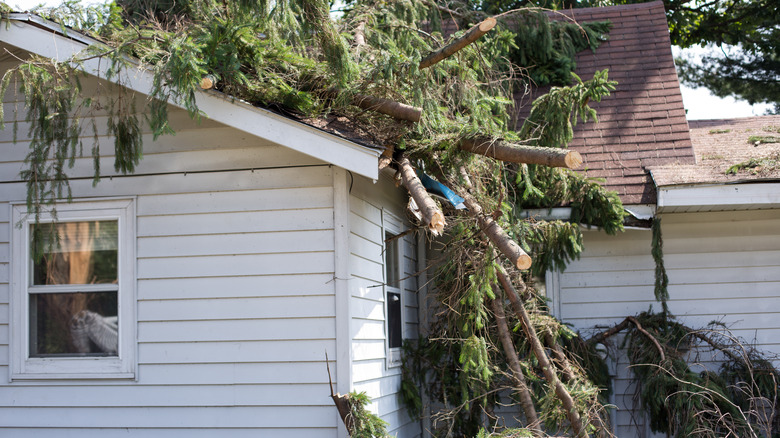What It Means To See A White Ribbon Tied To A Tree
If you stroll long enough through a forest or park you'll likely see a tree or two that has been adorned with a white ribbon tied around the trunk. This is not to be confused with decorative ribbons, which are often attached to serve as event decorations or sometimes to make a statement about a particular cause. Instead, white ribbons on trees are more often used to communicate important information about the tree itself. After all, trees don't have their own audible voices, so sometimes people have to step in and speak on their behalf!
Marking trees with paint, ribbons, flags, and other visual signs is a common practice by a variety of professionals. Doing so creates a visual aid for others to understand exactly what's happening in a given area. For example, an orange painted tree can indicate that it's about to be cut down or is dying and therefore potentially dangerous.
Interestingly, there's more than one reason for a white ribbon to be tied around a tree, and they are somewhat contradictory. On one hand, a white ribbon on a tree can indicate to workers and planners that they should not encroach on a young tree too closely because it needs room to grow. The other reason is that the beribboned tree might be past the point of no return, health-wise, and therefore needs to be cut down.
Pay attention to white ribbons on trees
Modern homeowners and city planners are learning from the mistakes of the past, when trees were planted super close to homes and other buildings. Sure, a tree might be dainty and small for a while, but eventually it's going to grow in size. A large tree and its roots can put homes and infrastructure at risk. However, lots of trees are already in the ground. Instead of taking these beauties down, people often prefer instead to work around them. They do this by tying a white ribbon around the trunk, which serves as a visual reminder to themselves and others that the tree is still growing, and therefore needs space. This helps planners avoid putting things like pools, sidewalks, drains, and other structures too close to the tree. Having a growing tree near these things can also stunt or even kill the tree.
For most major home improvement projects, a qualified contractor should be involved and should know how much room to give a growing tree so that it's far enough away from the home and other structures. The general rule of thumb is that the roots will eventually grow somewhere between 1.5 to 3 times the tree's height. So, a tree estimated to reach only 10 feet tall will need 10.5 to 30 feet of root-growing space! Of course, this varies based on the type of tree, so always consult an expert if you're unsure how much space a particular tree needs.
Why white ribbons are used to mark dead trees
A tree can also be marked with a white ribbon to indicate that it's dying or dead and so is slated to be cut down. Dead trees are more than just an eyesore, as unstable trees can cause lots of property damage if they fall on a house, or car. Even worse, a plummeting tree can harm a person.
Before it's removed, the cause of the tree's death has to be considered. If it died due to disease, the problem could spread to other trees, wiping out all that beautiful foliage. Dead trees are also magnets for wood-boring pests like termites, which can spread to a nearby building and cause all kinds of grief.
One important thing to note about tree marking systems is that they can vary between contractors and companies. So, just because one company uses white ribbons to mark a dying tree doesn't mean that another one will do the same. Some workers might use a white ribbon to simply identify which trees have been noted on a survey map, for instance. Because of this, it's best not to assume that you understand the meaning of a white ribbon on a tree. Instead, always consult the professional who put it there for an explanation.


